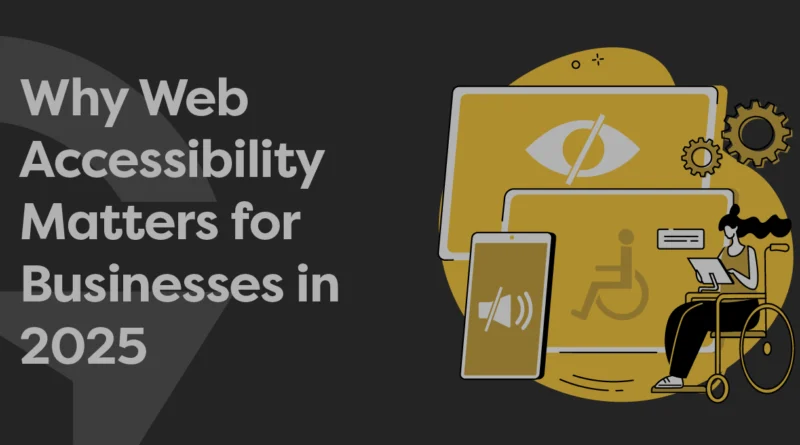Making Your Website Accessible: Key Trends and Best Practices for 2025
As the digital world keeps changing and growing, website accessibility continues to become a key issue rather than just an option that can be chosen. In 2025, digital experiences that are inclusive and easy to use will be the most important things for the designers, developers, and businesses. Less access time for a website means the users who are differently-abled do not enjoy equal access to information and definitely miss out. Let’s not forget the influence of accessibility as a crucial part of the SEO process and your brand’s reputation. Now, we are going to look into the latest website features that will be a talk in 2025 in terms of accessibility and the, of course, ground-breaking and must-follow basics of a digital experience that is high and mighty in the inclusiveness scale.
1. Inclusive Design Takes Center Stage
Inclusive design is the act of making digital experiences that can be used by everyone, irrespective of their age, ability, or background. It is forecasted that the trend in 2025 will be this that will dominate the web world. The designers are no longer just limited to the minimum requirements but are going forward to think about the user’s wide range of requirements in the early stages of the design process by themselves.
Best Practice:
Show empathy first. Carry out a research of users that has disabled people among the members. Use personas that provide a variety of suggestions to your UX/UI decisions
2. WCAG 2.2 and Beyond: Travel Towards Accessibility
Still the worldwide standard for digital accessibility are the Web Content Accessibility Guidelines (WCAG). The 2023 edition, WCAG 2.2, provides improvements mostly aimed at users with cognitive and mobility impairments. The websites have to satisfy such alterations and be ready for the remainder of the advancements by the time 2025 shows around.
Best Practice:
Generally speaking, continually verifying if your website is compatible using tools like Lighthouse, WAVE, or Axe. Not only should your web page satisfy the new success criteria including dragging motions, target size, and consistent assistance features, but also guarantee it satisfies WCAG 2.2 Level AA.
3. AI-powered improvements in accessibility
The mainstay is now artificial intelligence technologies used in online accessibility. From automatically produced graphics to tailored browsing experiences spanning all degrees of ability, artificial intelligence has expanded its value for web pages or sites to the level of not only being dynamic but also people-oriented.
Best Practice:
Using AI only as a supplement is one of the appropriate ways one may use it. Using AI-based screen readers or text-to–speech combination with the hand-checks would help to substantially increase usability; nonetheless, the main point is that automated solutions should be the last option rather than the first one in assuring compliance.
4. Voice Navigation and Assistive Tech Compatibility
Smart devices invention has heralded the age of voice navigation. Making certain that your website is supportive of assistive technologies such as screen readers, voice commands, and eye-tracking systems is absolutely necessary.
Best Practice:
Favourable semantic HTML as well as ARIA (Accessible Rich Internet Applications) labels utilization will bode well when aiming to better the compatibility of assistive tech with the website. The design of smart devices and screen readers which can be used together seamlessly must be the object of your thoughts while creating an unambiguous and brief voice navigation structure.
5. SEO and Accessibility Go Hand in Hand
Accessible websites are the ones that search engines like the most. User experience upgrades that clean code, image alt text, and structured content bring do not only make users feel better surfing your website; they do also have a positive impact on your site’s positioning in the search engine results pages. In 2025, Google is said to be the search engine that will consider the manner of website accessibility along with other factors to rank the website.
Best Practice:
The thing that we cannot miss here is a proper structure of content which involves using the right heading hierarchy (H1, H2, H3), alt text that refers to images, and the functionality of all the elements that are keyboard accessible. This combined efforts of SEO and accessibility can be taken as your two birds killed with one stone.
6. Accessible Color Palettes and Typography
Attractive websites in 2025 are those that follow a high contrast ratio color palette combined with clear typography and are easy to recognize for their grant of accessibility features. Not just style, the users will have to feel relaxed when detecting the visual cues on the website as well.
Best Practice:
Adopting Contrast Checker, a tool that checks the color and the contrast of the text based on the WCAG standards, would be a great way to begin. Utilize fonts that have readable characters in them and avoid utilizing images as text. Offer adjustable text size and dark mode as part of the user experience alternate features if it is possible to do so.
Final Thoughts
Accessibility isn’t just a design style in 2025; it’s an important part of doing good, user-centered web development. Businesses can make digital experiences that are more accessible to a wider range of people and do better in search results by following best practices and keeping up with the latest website trends.
Disclaimer
The information presented in this blog is derived from publicly available sources for general use, including any cited references. While we strive to mention credible sources whenever possible, Website Designer in Mumbai does not guarantee the accuracy of the information provided in any way. This article is intended solely for general informational purposes. It should be understood that it does not constitute legal advice and does not aim to serve as such. If any individual(s) make decisions based on the information in this article without verifying the facts, we explicitly reject any liability that may arise as a result. We recommend that readers seek separate guidance regarding any specific information provided here.

